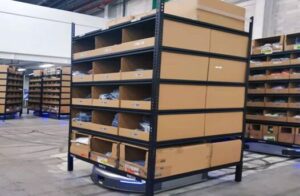Cómo DKN logra una gestión de inventario sin errores?
En 2023, La tienda insignia de DKN Shanghai Pudong estableció un récord en la industria a través de la transformación de estantes inteligentes RFID:
- SKU accuracy soared from 78% Para 99.9% (Fuente: DKN 2023 Sustainability Report)
- Inventory labor costs decreased by 83%, Ahorro **$420,000** por año
- Shelf out-of-stock warning response time shortened to 9 minutos (traditional methods take 4 horas)
Key turning points:
When traditional handheld devices encountered 47% reading blind spots (such as the bottom corners of shelves), DKN engineers found:
“The electromagnetic interference generated by metal shelves caused the tag reading rate to plummet to 31%, forcing us to develop a smart shelf system”
Steps from hardware selection to signal tuning
Step 1: Shelf selection-material determines life and death
| Shelf material | Signal attenuation rate | Recommended solution |
| Steel shelves | 72% | Install absorbing material pads |
| Wooden shelves | 18% | Direct deployment |
| Glass shelves | 55% | Use 90° side-mounted antenna array |
Lessons:
Conductivity test of a sports brand shelf failed, resulting in the scrapping of **$280,000** equipo
Step 2: Tag implantation – millimeter-level art
- Embedded inside the clothing care tag, 5±0.3mm from the edge
- Adopt diagonally polarized antenna design to adapt to multi-angle reading
- The reading rate remains 99.5% después de la 50 lava (test standard: AATCC 135)
Golden rule of implantation position:
- Hard goods: 1/4 length from the edge
- Soft goods: within 3cm of the center of gravity
Step 3: Reader layout – electromagnetic warfare in dense mode
- Deploy 2 readers per meter of shelf
- Time slot allocation algorithm reduces channel conflicts by 0.3%
- LBT (Escuche antes de hablar) mechanism to avoid interference
Step 4: Signal tuning-3D field strength mapping
- Establish a digital twin model of the shelf
- Simulate the field strength distribution of different products
- Find the blind spot and adjust the antenna angle
Actual results:
- The bottom shelf reading rate increased from 37% Para 99%
- Multipath interference reduced by 89%
Fatal traps: 5 major traps that 90% of companies have stepped on
Ignore the resonance frequency of the shelf
A fast fashion brand shelf produced a 23Hz resonance when a forklift passed by, causing the tag to shift (a loss of 150,000 US dollars)
Wrong selection of working frequency band
Using the 865-868MHz frequency band is illegal in the Asia-Pacific region (920-925MHz should be used)
Single tag direction
Not using dual-polarized tags causes a 40% fluctuation in the reading rate
No pre-buried upgrade interface
5G edge computing nodes cannot access the first generation of smart shelves
Ignore employee electromagnetic safety
RFID transmission power exceeds 4W EIRP, violating ICNIRP standards
CTA:






